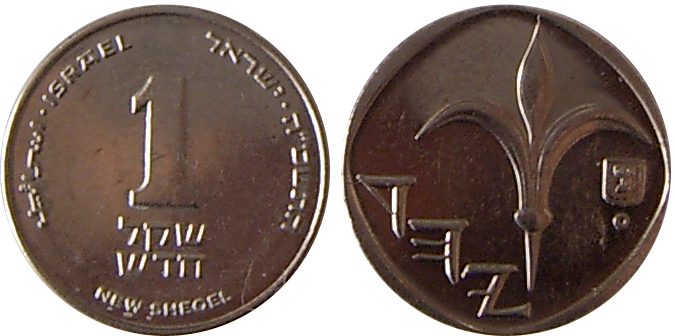|


The Israeli New shekel (Hebrew:Shekel Hadash) (sign: in English NIS; code: ILS) (also spelled sheqel; pl. shekalim pronounced shkalim - Arabic: shiqel jadid or shikel jadid) is the currency of the State of Israel. The shekel is divided into 100 agorot (sing. agora. Denominations made in this currency are marked with the shekel sign.
History
The new sheqel replaced the old sheqel on January 1, 1986 at a rate of 1,000 old sheqalim = 1 new sheqel.
Since January 1, 2003, the sheqel has been a freely convertible currency. Since May 7, 2006, sheqel derivative trading has also been available on the Chicago Mercantile Exchange.This makes the sheqel one of only twenty or so world currencies for which there are widely-available currency futures contracts in the foreign exchange market. It is also a currency that can be exchanged by consumers in many parts of the world.
On May 26, 2008, CLS Bank International (CLS Bank) has announced that it will settle payment instructions in Israeli New sheqel, thus making this currency fully convertible.
The currency is not produced in Israel, as the country has no mint. Currently, the coins are minted at Korea Minting and Security Printing Corporation (KOMSCO), the banknote and coin producer of South Korea, while the banknotes are produced in Switzerland.
For a wider history surrounding currency in the region, see The History of British Currency in the Middle East.
Coins
In 1985, coins in denominations of 1, 5 and 10 agorot, and 1 new sheqel were introduced. In 1990, 5 new sheqalim coins were introduced, followed by 10 new sheqalim in 1995.Production of 1 agora pieces ceased in 1990 too, and they were removed from circulation on April 1, 1991.[citation needed] A 2 new sheqalim coin was introduced on December 9, 2007.The 5 agorot coin, last minted in 2006, was removed from circulation on January 1, 2008.
Banknotes
In September 1985, banknotes were introduced in denominations of 1, 5, 10, 20 and 50 new sheqalim. The 1, 5 and 10 new sheqel notes used the same basic designs as the earlier 1,000, 5,000 and 10,000 old sheqel notes but with the denominations altered.
In 1986, 100 new sheqel notes were introduced, followed by 200 new sheqel notes in 1991. The 1, 5 and 10 new sheqel notes were later replaced by coins. A plan to issue a 500 sheqel banknote, carrying the portrait of Yitzhak Rabin, was announced shortly after Rabin's assassination in 1995. However, due to low inflation rates, there was no need for such a banknote, and it was never issued. However, in February 2008 the Bank of Israel announced that the planning of an entirely new series of banknotes has started, and that the new series, to be issued in 2010, will most probably include a 500 sheqel banknote as well.[citation needed] The design of the new banknotes has not yet been determined, but if the 20 new sheqel polymer banknote of the current series, introduced in April 2008, is successful, the new series will almost certainly consist of polymer notes only. Possible designs under review are: non-political famous personalities, such as Teddy Kollek (the legendary mayor of Jerusalem), Rabbi Shlomo Goren (IDF chief chaplain during the 1967 Six-Day War, famous for his shofar blowing on Jerusalem's Temple Mount minutes after its conquest by Israeli forces), Ilan Ramon (Israel's first astronaut who perished on the Columbia in 2003), Naomi Shemer (known as "First Lady of Israeli Song"). Other possible designs may include landscapes, flora and fauna of Israel. Reports in December 2009 indicated that the new bills, to be issued in 2012, would bear the images of Theodor Herzl, David Ben-Gurion, Menachem Begin, and Yitzhak Rabin, with the portrait on the 500 Sheqel bill to be determined.
The 20 sheqel banknote is the first, as of April 2008, to be made of polypropylene, a polymer substrate, which is superior to the current paper note with a circulation life of a few months only. The polymer note is printed by Orell Fuessli Security Printing of Zurich, Switzerland. 1.8 million of the new banknotes were printed with the writing "60 years [anniversary] of the State of Israel" (in Hebrew), in red ink.
The text on this page has been made available under the Creative Commons Attribution-ShareAlike License and Creative Commons Licenses
|
